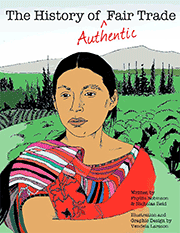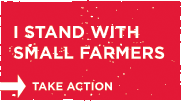 By Nicholas Reid, Equal Exchange Sales Rep
By Nicholas Reid, Equal Exchange Sales Rep
The price of coffee, like many other commodities (oil, sugar, and cacao for example) is sky-rocketing. While there are real supply issues in the market that are contributing to coffee prices being at their highest point in 14 years, one of the biggest factors behind rising coffee prices is actually being caused by speculation in the commodity market. And speculators, running amok in a system we dislike to begin with, are easy to blame. But understanding what is actually happening is more complex. Essentially traders are assuming that prices will continue to increase in the future, and so are buying up green beans and coffee contracts, to sell at a later date. As less supply and fewer contracts become available, speculators are creating a self-fulfilling prophesy… to their great advantage.
Commodity Markets
The pre-cursors to commodity markets were established in the United States in the mid-19th century. They were designed to manage risk for producers and consumers, and ease the intensity of market fluctuations. Commodity markets actually served as a useful tool in measuring demand and ensuring supply. “C-Markets” were essentially markets where buyers and sellers could negotiate contracts for future sales. Farmer X will deliver a certain amount of, say, wheat, to Buyer Y, on a specific date, at an agreed-upon price. The farmer knows how much money he will receive and how much to produce. The buyer knows what he will pay and how much he can expect to receive.
Previously, farmers had to estimate the market’s “demand” for a certain crop, and produce accordingly. Inevitably, human error and variable growing conditions led to shortages, when prices spiked, and over-production, when prices tanked; farmers lost money, and crops rotted.
Speculation
In its simplest iteration, speculation occurs because contracts are based in part on current market conditions (how much wheat is available, and how much it’s selling for on the “cash market”), but also on expectations of market conditions in the future. That is to say, supply of and demand for a certain good can change over time- due to weather, changes in technology, population growth… which affects the price. If you believe you can predict changes in supply or demand, you might be able to take advantage of that to turn a profit.
An example:
A wheat farmer might negotiate a commodity contract at the current market price- say it’s $5/bushel, with the terms of one month. Over the course of that month, there is a freak hail storm in Iowa, national wheat production is down 20%. A month later, people are willing to pay $6 for a bushel of wheat because it’s harder to come by. The farmer has technically just lost $1; since he is required to deliver the wheat to the buyer at the agreed-upon price of $5.
The buyer, in this scenario, say it’s a bakery, would have “made” $1, in that the current going rate for wheat is $6, but he got his for $5, and his cost of goods are lower than his competitors who didn’t buy their wheat on the commodity market.
Speculation Gone Wrong
The problem with today’s commodity markets is that the “actors” are rarely producers or consumers; they aren’t farmers and bakeries. The buyers and sellers are traders who have little or no interest in the good they’re trading, other than making a profit. They are essentially gamblers, who spend their days analyzing weather patterns, production trends, and potential shifts in demand.
This can, and often does, have the affect of distorting or intensifying market trends. If wheat production starts to decline (and thus, so does supply), commodity brokers will buy up contracts, assuming that prices will increase. In turn this drives prices up even higher, as the “supply” of contracts goes down, and there is less wheat available for purchase in the market. In contrast, if early indicators say the wheat crop in Iowa looks excellent, traders might “sell” their wheat futures (contracts) in anticipation of prices going down- which results in lower prices before the Iowa harvest occurs.
Coffee
The C-market for coffee is much like any other good. Exporters from producing countries sell contracts to deliver a certain quantity of green coffee on a certain date. Certified “Exchanges” grade and store the coffee in certified warehouses, as assurance to the buyer. The coffee, once it enters the warehouse, is essentially indistinguishable from any other “lot”.
Normally, the commodity market “works” in the sense that it helps regulate prices. As demand has risen in the past few decades, the C-market price has risen, and (at least theoretically) farmers have planted more coffee. Recently however, coffee production has peaked. Speculators continue to buy and sell contracts; but it’s becoming harder and harder to expand production to meet growing demand. Global warming and changing weather patterns have resulted in lower yields per hectare; which requires more and more land under cultivation just to maintain previous yields. At the same time, the average age of coffee farmers continues to increase, as younger generations are leaving the countryside to search for jobs in cities, leaving less labor to invest in new lands or crops. A real decrease in supply is made exponentially worse by the speculators; who see only the opportunity in the decreasing coffee production.
To make matters worse (for the C-market, anyway), more and more consumers are interested in higher quality coffee, and in specific varietal coffees- Colombian Excelso’s or Tanzanian AA’s- and they are willing to pay more for them. Since those coffees are not traded on the commodity market (where all the coffee is indistinguishable), more and more quality coffee is being traded outside the system, and at slightly higher prices. This had led to a perceived decrease in supply- there are fewer coffee contracts on the C-market because people are trading directly- on top of a real decrease in supply. All of which continues to drive up prices.
Fair Trade
What is especially frustrating for Equal Exchange, is how much of our work is designed to avoid the commodity market, and distorting affects like speculation. Our very mission is to connect consumers with producers, and circumvent the anonymity, unpredictability and downright inhumanity of the C-market. We purchase specific lots of coffee, directly from farmers. We constantly strive to know our partners, put a face to their products, and commit to long-term relationships with them. And despite our best efforts to escape the whims of the C-Market, we find ourselves struggling with its implications.
As demand for specialty coffees has increased, even non-Fair Trade buyers have been forced to pay well-above the minimum price (which floats up so that it never be below the C-Market Price), and Fair Traders like Equal Exchange pay even more still. At a time when the C-Market price is just under $3/lb, it adds upward pressure on prices for legitimate traders (like Equal Exchange) who actually roast and market the coffee, as opposed to just selling contracts for a profit.
At the end of the day, it seems likely the Commodity Market will “correct” itself at some point. It has happened in the past that prices have risen dramatically, only to fall to record lows thereafter. Farmers who have enjoyed record prices for their coffee over the past few years, will be left with whatever prices the market dictates; those that are not organized in Fair Trade co-operatives, or who have left those co-operatives thinking they can reach the “golden land” on their own, will be further at risk. That’s the nature of the Commodity Market- there is no room for relationships or human consideration. At that point, it will be traders like Equal Exchange who have strong relationships with Fair Trade co-ops on the ground in producing countries, who will continue to struggle to achieve their goal of fair prices for quality coffee, bringing our customers the best value we can provide.
Read Full Post »









